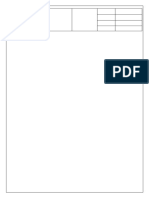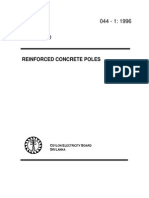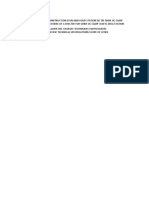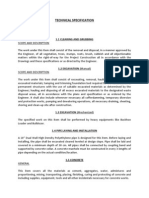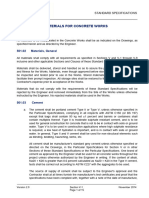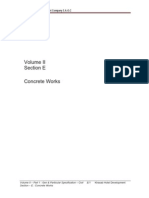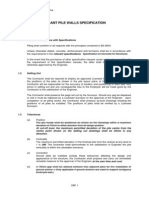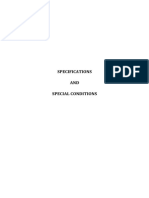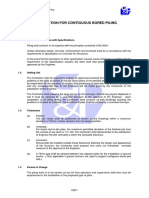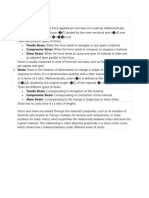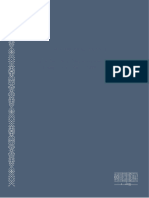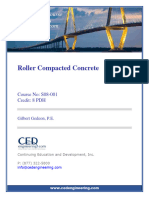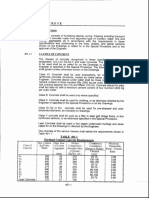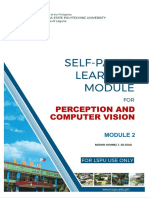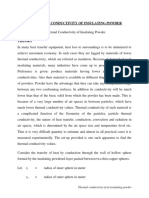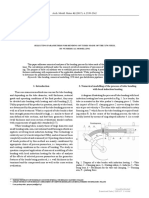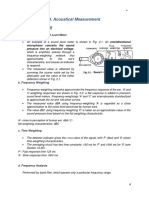Specification 3
Specification 3
Uploaded by
zhungjian586Copyright:
Available Formats
Specification 3
Specification 3
Uploaded by
zhungjian586Copyright
Available Formats
Share this document
Did you find this document useful?
Is this content inappropriate?
Copyright:
Available Formats
Specification 3
Specification 3
Uploaded by
zhungjian586Copyright:
Available Formats
AFGHANISTAN: EFSP Construction Work
Technical Specifications
May 2022
PART 3
3.01 Concrete General
Concrete shall consist of cement, graded aggregate and water thoroughly mixed, placed and compacted as specified.
All concrete work shall be carried out in accordance with ACI, ASTM and British Standard BS 8110 or any other
equivalent standard approved by the Engineer unless otherwise specified herein.
Before starting concreting the Contractor shall obtain formal written permission for concreting from the Engineer or
his representative on site. The Engineer or his representative shall allow concreting after ascertaining the required
lines and levels, suitability of formwork, availability of required plant and labour, proper fabrication and spacing of the
steel bars and quality and quantity of cement and aggregates.
3.02 Cement
All cement shall be from reputable manufacturers and conform to international standards (ASTM C 150 or BS 12).
Cement shall be stored where it cannot be damaged by rain or moisture and shall be free of lumps when used.
Sulphate-resisting cement shall be used for foundations and ordinary Portland cement for other works or as directed
by Engineer or his representative.
3.03 Tests on Cement
Before any cement is ordered or brought on to the site, the Contractor shall submit to the Engineer a detailed list of
the sources, country or countries of origin and manufacturer’s brand names of the types of cement which he proposes
to use.
The Contractor shall submit to the Engineer, without charge, test certificates relating to each consignment of cement.
Each certificate shall show that a sample of the consignment has been tested by the manufacturer or by an approved
laboratory and that it complies in all respects with the requirements of the Technical Specifications.
The cement will be tested in accordance with and shall meet the requirements of the relevant ASTM C 150 or BS
Code. When required by the Engineer the Contractor shall supply to the Engineer samples of cement taken on
delivery to, or during storage on the Site, for testing at a nominated laboratory without extra charge.
The Engineer may call for new tests, at the Contractor’s expense, in particular if the cement has been stored for a long
time, to check the cement is still conforming to the requirements.
3.04 Cement Measured by Weight
All cement, sand and aggregates used in the works shall be measured by weight according to the approved mix design.
Cement from partly filled or unsealed bags shall not be used. In the case of cement, direct weighing of the cement
shall be carried out for batching because of the varying density of cement. However, in the case of sand and
aggregates, standard density is considered and the weight is converted into volume and batching will be done
accordingly.
3.05 Rejection of Cement
Notwithstanding the receipt of the test certificate as required by Clause 3.03, tests on Cement, and the approval of the
Engineer, the Engineer may reject any cement as a result of further tests on compressive strength, setting time and
chemical composition. The Engineer may also reject cement which has deteriorated owing to inadequate protection or
other causes or in any other case where the cement is not to his satisfaction. Re-tests, if required, are at the
Contractor’s expense. The Contractor shall remove all rejected cement from the site without delay and at his expense.
3.06 Concrete Aggregates
All concrete aggregates (sand & gravel) shall be furnished by the Contractor from any source approved by the
Engineer. They shall be free from organic material, lumps of soft material, clay, chalk, lime, peat, loam, soft clayey
shale or decomposed stone, vegetable and other impurities that may be harmful to concrete.
Page 10
File: A EFSP-TECHNICAL SPECIFICATIONS-II
AFGHANISTAN: EFSP Construction Work
Technical Specifications
May 2022
Sand for concrete shall be free of stones larger than 2 mm and not include significant amounts of silt and clay. If sand,
when dried after wetting, adheres together then it shall be considered unsuitable.
Gravel for concrete shall be uniformly graded and consist of hard and dense rock. The gravel shall be free of materials
finer than 5 mm and the surface shall be clean. Gravel for use in reinforced concrete shall be crushed aggregates.
Generally, natural gravel and/or crushed aggregates particles shall be spherical or cubical in shape. The maximum
nominal size of the gravel shall be eighty (80) mm in mass concrete and twenty (20) mm in other concrete structures.
Aggregates for concrete shall comply with ASTM or BS EN 12620:2002
Approval of a source of aggregate by the Engineer shall not be construed as constituting the approval of all materials
to be taken from that source and the Contractor shall be responsible for the specified quality of all such materials used
in the Works. The Contractor shall not obtain aggregates from sources which have not been approved by the
Engineer.
During the performance of the Contract, the Contractor shall supply samples of aggregates when required by the
Engineer at a frequency at least once monthly, or as directed by the Engineer from each source of aggregate approved.
If the routine tests carried out by the Engineer show the aggregate to be not to the same standard as originally
approved, then subsequent testing to obtain acceptable aggregates shall be undertaken by the Contractor at his cost.
Aggregate shall be washed and screened as necessary to produce aggregates meeting the specified requirements. All
such washing and screening shall be to the satisfaction of the Engineer. The costs of all washing and screening shall be
included in the Contract Rates.
Aggregates shall be stored in separate stockpiles in such a manner that the intermingling of materials from separate
stockpiles or bins is not possible and so as to prevent contamination by mud, rubbish, windblown dust or vegetation.
Aggregate stockpiles shall be provided with adequate drainage to ensure rapid drainage of the aggregates. The storage
arrangements shall be to the approval of the Engineer.
Coarse aggregates shall be well graded within grading limits given ASTM C33.
3.07 Water for Concrete
Clean fresh water is to be used for the mixing of all concrete and mortar. Water that is safe to drink shall be
considered suitable for making concrete.
3.08 Steel Reinforcing Bars
Reinforcing steel under this type comprises Grade-60 Deformed re-bars. The steel shall conform to ASTM A 615M
Specification of yield strength not less than 420 MPa (N/mm2). The structural grade shall be made from billets. The
ends of the bar shall be machine sheared perpendicular to the axis of the bar.
The Contractor shall supply samples or reinforcement from the stocks on site when required by the Engineer and
shall forward the samples for testing as directed.
The Contractor shall prepare test specimens of steel reinforcement to be used in the works. Test specimens shall be
taken in the presence of the Engineer and shall be of a size sufficient to carry out the specified test. The test
specimens shall be tested in an approved laboratory and the certified copies of the results of the tests shall be
submitted to the Engineer. The specimen shall be tested for bending and tensile properties. The methods and
requirements for testing shall be carried out in accordance with the applicable specifications of relevant ASTM or BS.
If necessary, other equivalent Standards may be followed/ substituted after obtaining the approval of the Engineer. If
ordered by the Engineer, test procedures shall be repeated at the Contractor’s own expense for any new supply of steel
reinforcement.
The Contractor shall be responsible for the accuracy of the cutting, bending and placing of the reinforcement.
Reinforcement will be inspected for compliance with the requirements as to grade, size, shape, length, splicing
locations, position and amount after it has been placed.
Reinforcing bars or fabric shall be accurately placed and secured in position so that there will be a clear distance of at
least 25 mm between the bars or fabric and any adjacent embedded metal work and so that the bars and fabric will not
be displaced during the placing of concrete, and the Contractor shall ensure that there is no disturbance of the
reinforcing bars or fabric in concrete that has already been placed.
Chairs, hangers, spacers and other acceptable metal, plastic or concrete supports may be furnished and used by the
Contractor for supporting reinforcing bars or fabric.
All reinforcement bars shall, immediately prior to placing, be free from loose mill scale, loose rust, oil, grease, dirt or
other foreign matter. Reinforcement is to be placed and secured in the exact position as indicated on the drawings and
kept in the correct position in the forms without displacement during the process of vibrating, tamping and ramming
the concrete in place. All free ends of the plain round bars shall have hook as shown on the drawings or as directed by
Page 11
File: A EFSP-TECHNICAL SPECIFICATIONS-II
AFGHANISTAN: EFSP Construction Work
Technical Specifications
May 2022
the Engineer. Bars shall be bound together with best mild steel wire which shall be twisted tight with proper pliers.
The free ends of the binding wire shall be bent inward.
Minimum concrete cover to reinforcement should be 50 mm measured from the outside of the bar, unless shown on
the drawings or directed by the Engineer.
The Contractor must inform the Engineer of the completion of any reinforcement in time, in order to facilitate its
inspection and check of conformity with the Working Drawings well before the concrete is placed. Relevant
formalities shall be agreed upon between the Contractor and the Engineer at the appropriate time.
When the reinforcement has been placed and is ready for concreting, it will be inspected by the Engineer, and no
concrete shall be placed until the reinforcement has been approved by him. The Contractor shall inform the Engineer
at least 48 hours in advance of his intention to have the reinforcement ready for inspection.
3.09 Drawings and Bar Lists
Steel reinforcing bars or fabric shall be placed in concrete where shown on the Drawings or directed.
A bar bending schedule may be provided for the Contractor's convenience, but does not constitute a Contract
Document The Contractor shall prepare for additional structures, in an approved manner, reinforcement detail
drawings showing reinforcement bar lists, bar placement details and bar bending details for each structure, if not
provided by the Engineer.
All reinforcing bars shown on the reinforcement detail drawings shall be identified on the bar lists in accordance with
the standard reinforcing bar shapes as shown on the Drawings.
All bar lists shall be identified with the relevant reinforcement detail drawing and all bars scheduled on the bar lists
shall be defined and dimensioned in a manner approved by the Engineer.
3.10 Storage of Steel Reinforcement
Steel reinforcement shall be stored above the ground on platforms, skids or other approved supports, and shall be
protected from mechanical injury and surface deterioration caused by exposure to conditions producing rust. Different
types and dimensions of reinforcement shall be kept separately.
3.11 Cover to Reinforcement
Except where otherwise shown on the Drawings or ordered by the Engineer, the concrete cover in the finished
Permanent Works to the nearest reinforcement (exclusive of concrete blinding, plaster or decorative finishes) shall be
50 mm. This requirement does not apply to concrete faces in box-outs left for the installation of gates, etc. Cover shall
be maintained by the use or minimum practical number of purpose made concrete blocks or approved spacers.
Concrete spacer blocks shall be made from cement, sand and small aggregate to match the mix proportions of the
surrounding concrete as far as is practicable to ensure comparable strength, durability and appearance. The cost of
spacer blocks and chairs shall be included in the Contract Rates.
3.12 Concrete Classes
The classes of concrete to be used in the Works shall be as shown on the Drawings, Bills of Quantities or as directed
by the Engineer. The concrete is classified on the basis of its compressive strength at twenty eight (28) days as well as
the maximum size of the aggregate as shown below and nominal mix proportions shall be used only as a guide.
Concrete Max Concrete Characteristic Maximum Maximum Approx. Nominal Mix
Slump(mm) Class Cube Strength at Aggregate water/ cement cement proportions
28 days (kg/cm2) size(mm) ratio (%) content (Kg/m3)
75 M25 250 20 45 400 1:1:2
75 M20 200 20 45 400 1 : 1.5 : 3
75 M15 150 20 50 310 1:2:4
100 M10 100 20/80 55 220 1:3:6
100 M5 50 20 60 170 1:4:8
Type Description
M25
Reinforced concrete for superstructure of bridge, flume, pre-cast concrete slab, etc.
M20
M20/M15 Plain concrete for mass concrete and concrete lining.
M10 Plain concrete for mass concrete/ordinary plain concrete
Page 12
File: A EFSP-TECHNICAL SPECIFICATIONS-II
AFGHANISTAN: EFSP Construction Work
Technical Specifications
May 2022
M5 Plain concrete for foundation and filling purpose (blinding).
3.13 Designed Mix Concrete
The Contractor shall determine to the approval of the Engineer the actual proportions of ingredients for each class of
concrete according to ACI 211, ACI318.
Under field conditions, the Contractor shall make trial mixes for each class of concrete using the same type of
Constructional Plant and the same materials as are proposed for the Permanent Works. The Contractor shall give 24
hours' notice of such trials to enable the Engineer’s Representative to attend.
The Contractor shall not commence concreting in the Permanent Works until a trial mix design for the class of
concrete required has been approved by the Engineer.
Mix Design shall be the contractor’s sole and ultimate responsibility.
If the samples strength derived from these tests do not reach the desired value, the mix shall be redesigned at no extra
cost to the Employer.
Adjustments to the concrete mix proportions will only be made if, in the opinion of the Engineer, such adjustments
are necessary.
The Contractor shall not alter the mix proportions or the source of supply of any of the ingredients without having
previously obtained the approval of the Engineer.
3.14 Consistency
The concrete shall be of such consistency that it can be readily transported, placed and compacted in the Works
without segregation of the materials. The resulting concrete shall be uniform and free from honey-combing. The
consistency of the concrete as determined by the slump test shall be within the range of 5 cm to 10 cm. Samples for
slump determination will be taken from the concrete during placing in the formwork.
3.15 Estimation of Air content
The approximate amount of air to be expected in normal concrete and air entraining concrete according to the
approved mix design
3.16 Costs of Testing and Sampling of Concrete and Concrete Materials
The costs of all sampling, transport of samples and testing in connection with the concrete shall be in accordance with
the Conditions of Contract and these Technical Specifications and such costs are to be borne by the Contractor.
These costs shall be deemed to be included in and covered by the Bill of Quantities.
3.17 Compliance with Strength Requirements
The compressive strength of the concrete shall be based on the compression testing of concrete cylinders made and
tested in accordance with Specification. Of the six cylinders made from each sample of fresh concrete and cured in the
laboratory, three will be crushed at 7 days and the other three at 28 days. The average of the three 28 day strengths will
be taken as the test result. Compliance with the specified strength requirements shall always be judged on the 28 day
test results according to ACI 318.
In case, seven (7) days strength shows less than seventy (70) percent of the twenty eight (28) days mean strength (in
case of type-1 cement),Engineer may stop further work on that particular portion of concrete, unless twenty eight (28)
days strength gives satisfactory results.
3.18 Concrete Sampling and Testing
During manufacture and placing of concrete, unless otherwise directed by the Engineer, at least two samples for each
50 cum of concrete shall be taken, but the Engineer may at any time vary the rate and number. Higher rates of
sampling and testing may be used at the start of the Works to establish the quality quickly or during periods of
production when quality is in doubt.
All samples shall be random samples, taken in the presence of the Engineer, moulded and cured and tested in
accordance with the requirements of ASTM and ACI.
Page 13
File: A EFSP-TECHNICAL SPECIFICATIONS-II
AFGHANISTAN: EFSP Construction Work
Technical Specifications
May 2022
The Contractor shall provide the necessary equipment, labour and transport for carrying out the sampling and testing
in the proposed and approved Laboratory by Engineer.
The concrete test samples shall be stored and tested at the Laboratory under the supervision of the Engineer.
Unless otherwise instructed, each set of samples tests shall consist of 6 cylinders, three cylinders shall be crushed 7
days after mixing, and three cylinders shall be crushed 28 days after mixing. The day of casting is to be clearly marked
on the cylinders.
Records of concrete sampling and testing shall be kept by the Contractor and forwarded to the Engineer within 24
hours of sampling and testing. Samples for testing shall be taken at the point of discharge into the Works.
The concrete shall be compacted by hand and well covered with wet gunny bags, all in the shade. After 24 hours in the
mould the cylinders shall be taken out and put in water. They shall be kept there until sent to the laboratory, well
covered with wet gunny bags. In the laboratory the cylinders shall be kept in water until being crushed, unless
otherwise specified. The curing water at the site shall be well shaded. Unless otherwise directed by the Engineer the
frequency of sampling the concrete shall be at the rate of one sample for every 10 m3 of concrete for important
structures. Where more than 30 m3 of concrete is placed in one location in one day or for scattered work, the rate of
sampling shall be specified by the Engineer. No additional payment will be made for carrying out sampling and testing.
The Engineer may direct the non-destructive test to the contractor for the completed portion of the concrete work as
necessary. No separate payment will be paid for such tests.
3.19 Core Test
The contractor at his expenses provides evidence consists of tests made on cores taken from the work to prove that
the strength and quality of concrete placed in the work are acceptable.
Core Testing is resorted to under following conditions:
1. When the 28 samples results do not meet the specified acceptance criteria,
2. When the samples tests had not been taken or the results are disputed,
The points from which cores are to be taken shall be decided by the Engineer. The cores shall be obtained and tested
accordance with the specifications of AASHTO T-24 or another approved standard. A minimum of three cores shall
be tested. The core strength should be converted to equivalent cube strength. If the strength of equivalent cube
obtained is at least 85% of characteristic of concrete grade and no strength of an individual core is obtained less than
75%, then strength of the concrete shall be considered acceptable.
If the strength of equivalent samples for mass concrete, plum concrete and PCC obtained is at least 70% of
characteristic of concrete grade and no strength of an individual core is obtained less than 65%, then 0.7 times the
characteristic value at the discretion of Designer shall be accepted as being structurally adequate. However, a rebate of
20% shall be taken over the quoted item rate.
3.20 Mixing Concrete by Machine
Unless otherwise authorized by the Engineer, concrete shall be machine mixed at site.
Where the concrete is to be mixed in machines, these shall be of the batch mixing or other approved type. The
machines shall ensure that all the concreting materials including the water are thoroughly mixed together before any
portion of the mixture is discharged. The machines must be capable of discharging their contents while running.
All classes of concrete shall be mixed for a period not less than 1½ minutes after all materials, including water, are in
the mixer. All mixing water shall be introduced before one-fourth of the mixing time has elapsed. The mixers shall not
be loaded beyond their rated capacity, nor be operated at a speed in excess of that recommend by the manufacturer,
generally between 15 to 20 revolutions per minute. The mixer shall produce a concrete of uniform consistency and
appearance. All mixing equipment shall be cleaned before commencing mixing and shall be kept free from set
concrete.
3.21 Mixing Concrete by Hand
Where concrete is mixed by hand, this shall be done as near as practicable to the site where it is to be deposited. Clean
mixing bankers of platforms of sufficient areas for the proper execution of the work shall be provided. These
platforms if constructed of timber shall consist of planks closely jointed so as to avoid the loss of any grout or liquid
from the wet concrete. The whole of the aggregate and cement shall be turned over on the banker in a dry state at
least three (3) times. The water shall then be added gradually through a rose head, after which the materials shall again
be entirely turned over in a wet state at least three (3) times before leaving the banker.
3.22 Foundation Preparation for Concrete
Page 14
File: A EFSP-TECHNICAL SPECIFICATIONS-II
AFGHANISTAN: EFSP Construction Work
Technical Specifications
May 2022
Before placing concrete on foundations, the Contractor shall remove from all such surface oil, objectionable coatings,
loose or unsound fragment of earth mud, debris and standing water, to the satisfaction of the Engineer and he shall
keep such surfaces clean and free from standing water during concreting operations. Where new concrete is to be
deposited on or against rock, the surface of the rock shall be toothed to form an adequate bond
3.23 Concreting of Massive Structures
In concrete masses intended to form a watertight curtain in the ground, the concrete shall be placed in one operation
from the bottom of the trench up to ground level or up to general foundation level over the whole length between
two pre-arranged construction joints.
In other structures the concrete is to be shuttered off in rectangular sections the width of the block sufficient for the
day's work and each section must be completely filled in one continuous operation.
The first lift of concrete in mass concrete structures shall not exceed 0.75m in height. Subsequent lifts shall not exceed
1.50m in height.
All lift joints in mass concrete structures shall be provided with shear keys unless otherwise ordered by the Engineer.
Shear keys of minimum depth 0.15m shall be formed in the lower lift.
3.24 Prevention of Cracking in Mass Concrete
The requirements of mass concrete the Contractor shall control the temperature of the mix and the setting concrete to
the satisfaction of the Engineer to ensure a sound uncracked structure.
This shall be achieved by controlling the temperature (a) of the concrete ingredients and the concrete mix and (b) of
the concrete during placing and curing. The temperature of the concrete during curing shall not exceed 50oC. To
achieve this it is anticipated that water cooling or ice making plant may be required to reduce placing temperatures of
the concrete.
Concrete shall be carried out in alternative blocks. Lifts shall not exceed 1.50m and shall be poured in three layers each
starting at the upstream face.
The time interval between lifts shall not be less than two days or, in general, more than seven days. If the period
between lifts exceeds ten days the height of the subsequent lift shall not exceed 0.75m.
At any one time the difference in level between adjacent blocks shall not exceed 4.50m.
3.25 Placing of Concrete
The Engineer’s approval in writing shall always be obtained before any concrete is placed in the Works. Concreting
shall be done in the presence of the Engineer or his representative. The arrangements for placing concrete are to be
such that in all cases the material may be conveniently handled and placed in the required position without re-handling
or segregation. Except where otherwise directed, concrete shall not be placed unless the Engineer or his representative
is present and has previously examined and approved the positioning, fixing and condition of reinforcement and any
other items to be embedded and the cleanliness, alignment and suitability of the containing surfaces or formwork.
In placing concrete through reinforcement, care shall be taken that no segregation of the coarse aggregate occurs. On
the bottom of beams or slabs, where the congestion of steel near the forms makes placing difficult, a layer of mortar
of a composition compatible with the required concrete strength as directed shall be first deposited to cover the
surface to a depth of approximately 3 cm.
Concrete shall not be placed in or in contact with standing or running water unless so specified or approved. Concrete
shall not be placed against placed concrete which has been in position for more than 30 minutes unless a construction
joint if formed as hereafter specified. When stoppage of concreting operations occurs for any reason, construction
joints shall be placed. Before concreting operations are resumed, the surface of the concrete shall be cut or chipped to
remove all laitance and to expose the aggregate. The surface of the concrete shall be thoroughly saturated and coated
with a proportion of weight of 1:2 cement mortars one (1) cm thick before the placing of the concrete is resumed.
Concrete as reinforced concrete work shall be deposited in small quantities in a plastic state with a water cement ratio
such to give the specified strength. The depositing of concrete in individual members shall be continued without
stoppage up to an approved pre-arranged construction joint or until the member is completed and shall be finished off
in such a manner that the junction of members shall be monolithic unless otherwise specified.
3.26 Concreting in High or Low Ambient Temperature
Where the ambient temperature exceeds thirty two degrees Celsius (32°C), the Contractor shall take special measures
in the mixing, placing and curing of concrete. The temperature of the concrete when deposited shall not exceed thirty
Page 15
File: A EFSP-TECHNICAL SPECIFICATIONS-II
AFGHANISTAN: EFSP Construction Work
Technical Specifications
May 2022
degrees Celsius (30°C). The Contractor shall carry out all necessary special measures to ensure that the maximum
concrete temperature after placing shall not exceed thirty degrees Celsius (30°C) at the time of placing. During placing
suitable means shall be provided to prevent premature stiffening of the concrete placed in contact with hot surfaces.
The Contractor shall not mix and place concrete when the ambient temperature falls below three degrees Celsius
(3°C).
3.27 Concreting in Adverse Weather
No concreting will be allowed to take place in the open during storms or heavy rains/ snowfall. Where strong winds
are likely to be experienced additional precautions to ensure protection from driving rain and dust shall also be taken.
The Engineer may withhold approval of commencement of concreting until he is satisfied that full and adequate
arrangements have been made.
3.28 Vibration of Concrete
Except where otherwise permitted by the Engineer, concrete shall be fully compacted throughout the full extent of the
layer and shall be brought up in level layers of such depth that each layer is readily and properly incorporated with the
layer below with the use of internal vibrators or by spading, slicing or ramming. It shall be thoroughly worked against
formwork and around any reinforcement or embedded items without displacement. The internal concrete vibrator will
be arranged by Contractor himself.
The duration of vibration shall be limited to that required to produce satisfactory consolidation, without causing
segregation. Vibration shall, on no account, be continued after water or excess grout (if any) appears on the surface.
3.29 Curing and Protection
The Contractor shall take adequate measures to ensure that the concrete shall be kept damp continuously for a
minimum of three (3) days after casting or for such other time as the Engineer may direct. After removal of this
covering (layer of sacking, canvas, Hessian, straw mats or similar absorbent material or a layer of sand), the concrete
shall then be sprayed with water for minimum period of a further fourteen (14) days.
All concrete liable to be affected by running water or wave action shall be adequately protected from damage during
the setting period and all temporary protection works shall be to the satisfaction of the Engineer.
3.30 Faulty Work
Any portion of the work which is honeycombed or otherwise inferior shall, on the written instruction of the Engineer,
immediately be cut out and reconstructed in an approved manner without extra charge. Plastering of defective Works
shall not be permitted.
3.31 Joints in Concrete
Joints in concrete shall be provided in manner and position as shown on contract drawings. In the case of water
retaining structures, joints shall be made water-tight by the provision of a continuous waterstop, with suitable water
resistant filler material and sealant as approved by the Engineer.
Joints required by the Contractor but not intended by the Exhibited Design are in principle subject to the Engineer's
approval. The location and design of such joints are to be depicted in the Drawings that are then to be submitted to
the Engineer in sufficient time. In determining the location of joints, the Contractor must consider the static
requirements of the respective structural member, as well as the special local and climatic conditions.
3.32 Construction Joints
Definition: Concrete surfaces, upon or against which concrete is to be placed and to which new concrete is to adhere,
that have become so rigid that the new concrete cannot be incorporated integrally with that previously placed, are
defined as construction joints.
Location of Construction Joints: The Contractor shall submit for approval, drawings showing his proposed location of
construction joints not less than 30 days before placing concrete.
Forming Construction Joints: Construction joints shall be approximately horizontal or vertical unless otherwise shown
on the Drawings or directed and shall be given the prescribed shape by the use of forms, where required, or by other
means that will ensure suitable jointing with subsequent work; provided that unless otherwise shown on the Drawings,
key-ways will not be required at construction joints. All intersections of construction joints with concrete surfaces
which will be exposed to view shall be made straight and level or plumb.
Page 16
File: A EFSP-TECHNICAL SPECIFICATIONS-II
AFGHANISTAN: EFSP Construction Work
Technical Specifications
May 2022
3.33 Joint Sealer
The joint sealing material must be resistant to oil, the most common chemicals and sunlight. It shall be of permanent
elasticity, be suitable to carry the structural deformations and must possess an outstanding adhesion to the concrete.
The elastic extension must be at least 150 % and the resistance to heat shall be between 50 degrees Centigrade and
+120 degrees. Centigrade, which are to be confirmed by submission of verified test certificates.
Joint sealer shall be the make of a recognised manufacturer, such as THIPFLEX 600 of EXPANDITE or equivalent
approved. Joint sealer shall be supplied with primer coats, backing material and/or bond breakers to the joint fitter, as
required by the manufactures recommendations.
The Contractor shall submit to the Engineer a statement from the manufacturer(s) of the joint filler and sealing
materials, that these materials are suitable under the prevailing local and structural conditions.
3.34 Joints to Existing Structures
Where concrete is to be cast against existing concrete, the existing concrete shall be cut back at least 150mm to expose
clean reinforcement and a sound irregular clean concrete face. The face shall be painted with epoxy resin in
compliance with the manufacturer's instructions prior to placing the new concrete.
3.35 Waterstops
Size and Material: Waterstops, nominally 225 mm wide, shall be placed in joints of concrete structures as shown on
the Drawings or as directed. The waterstops shall be of extruded polyvinyl chloride complying with BS 2571: Class 3,
Compound Type G4, CRD -C 572-74 or ASTM standard. The waterstops shall be of sufficient stiffness so that they
remain in their correct position during concreting. The type shall suit the particular location in the structure in which
the waterstop is to be placed and the pattern shall be such that concrete can be placed all around it with complete
consolidation and no voids or crevices.
Waterstops used in each location shall include at least on approved nailing strip so located that the efficiency of the
waterstop is not impaired, shall have a minimum thickness of 4 mm and shall be as approved. The width of the
waterstop shall be within a tolerance of 10 mm of the nominal width exclusive during storage. The Contractor shall
store the waterstops in such a way that the material does not deteriorate during storage.
Joints: The number of joints in the waterstops shall be the minimum practicable and all joints and bends shall be made
as approved by the Engineer. The number of straight field joints shall be kept to a minimum and all 'Tee' and 'Cross'
joints shall be factory produced. The Contractor shall protect the waterstops against perforation or damage during the
progress of the work. All joints shall be made in such a manner as to ensure:
that the material is not damaged by heat, searing or by the application of cementing materials:
that the splices have a tensile strength not less than 80 per cent of that required of the specified
material;
that the splice is watertight and free of air bubbles, and
That the ribs and central bulb, where applicable, match up exactly and are continuous.
3.36 Form Work
Formworks for concrete shall be constructed from materials of sufficient strength and supported to ensure that there
is no deflection when concrete in placed. Formwork for the concrete structures shall be made from steel. The steel
formwork shall be accurately aligned and with close fitting joints. The outside of the steel formwork shall be painted in
a light colour to prevent extreme temperatures due to solar radiation.
Only with the approval of the Engineer can formwork be made from good quality seasoned timber, free from loose
knots, shakes and warped surfaces. This timber shall not be less than 30 mm in thickness and the board faces in
contact with concrete and the board edges shall be planed smooth and joints shall be tongued and grooved.
The formwork shall conform to the shapes, lines and dimensions of structures shown on the drawings. Where the
concrete finished surface is exposed, the formwork shall be of good quality and free of gaps. Formwork shall not be
removed until the concrete has obtained sufficient strength. Normally, formwork can be removed from walls after 2
days and from beneath slabs after 2 weeks.
The minimum periods between concreting and the removal of forms shall be as follows:
Sides of beams, walls, columns and piles 24 hours
Soffits of secondary slabs (props left in) 4 days
Soffits of main slabs (props left in) 8 days
Soffits of beams (props left in) 8 days
Removal of props - secondary slabs 10 days
Removal of props - beams and main slabs 21 days
Arch centres, wedges eased 8 days
Page 17
File: A EFSP-TECHNICAL SPECIFICATIONS-II
AFGHANISTAN: EFSP Construction Work
Technical Specifications
May 2022
Arch centres, struck 21 days
The times in the above table are given as a guide and are based on average weather conditions and the use of Ordinary
Cement. They may be changed if other types of cement are used, subject to the Engineer's agreement. Formwork shall
be constructed so that it can be removed without undue shock or vibration and so that side shutters of members can
be removed without disturbing the soffit shutters; if the contractor wishes to leave some of the props in place when
the soffit shutters are removed, these props shall not be disturbed during the striking. The detailed arrangements of
the props shall be submitted in advance to the Engineer. In the case of heavy loading, folding wedges shall be
provided. For pre-stressed units the side shutters shall be eased as early as possible and the soffit shutters shall permit
movement of the units when the pre-stress is applied. All formwork must be removed without damage to the
concrete.
3.37 Concrete Surface Finish
The concrete surface shall be thoroughly worked during the operation of placing by means of a broad tined fork or
concrete spade of an approved type. The working shall be such as to force all coarse aggregate from the surface by
screeding and trowelling with a wood float to produce a smooth finish free from water and air pockets or honey
comb. Screeding shall be carried out, following compaction of the concrete, by the slicing and tamping action of a
screed board running on the top edges of the formwork or screeding guides to give a dense concrete skin true to line
and level. Wood float trowelling shall be carried out after the concrete has stiffened and the film moisture has
disappeared.
3.38 Pre-Cast Concrete
With the approval of the Engineer the Contractor may pre-cast members which were specified to be constructed in-
situ. Pre-cast concrete units shall be of concrete strength as indicated on contract drawings or as indicated by the
Engineer. The concrete pre-cast units shall be cast in horizontal position, unless otherwise directed by the Engineer.
In general same concrete quality measures should be applied as for other concrete component. Generally members
which are structurally dependent on a rigid fixing with adjoining structures will not be permitted to be constructed by
pre-casting.
Pre-cast units shall be jointed with cement mortar as specified or other jointing system as shown on the Drawings, or
as directed by the Engineer. The mortar shall be packed in layers between the units with steel tools until the whole of
the joint is solidly filled and the exposed surfaces of the joint shall be raked out to a depth of 6 mm and flush pointed
with similar mortar, but of pointing consistency.
The quality, tests, trial mixes and test cylinders of the concrete shall be made, all in accordance with concrete work of
these Technical Specifications.
3.39 Cement Mortar
Cement mortar shall be machine mixed and unless otherwise specified, consist of three (3) parts of sand to one (1)
part of Ordinary Portland cement mixed and thoroughly incorporated together. Just enough water will be added to
give workability appropriate to its use. The above proportions are by volume. Mortar shall be used whilst freshly
mixed and no softening or re-tempering will be allowed.
3.40 Concrete Pipe Culverts
General: The Contractor shall construct concrete pipe culverts under access roads as shown on the Drawings or as
directed. Concrete pipes for culverts shall be between 450 mm and 600 mm in diameter or as directed by the
Engineer, shall conform to the requirements of standards approved by the Engineer and shall be standard grade
reinforced pipes with spigot and socket joints. All joints in concrete pipes shall be sealed with cement mortar as
directed.
Installation: Pipes shall be laid in trenches in solid ground or in drainage depressions in locations approved by the
Engineer. Compressible and other unsatisfactory material on the bottom of the trenches shall be removed as directed
before laying the pipes.
Unless otherwise shown on the Drawings or directed by the Engineer, all pipes for concrete pipe culverts shall be laid
on a 150 mm thick layer of selected fine granular bedding material and properly jointed. The bedding material shall not
contain stones or rock fragments having a maximum dimension greater than 10 mm and shall be obtained from
sources approved by the Engineer. Bedding materials shall be compacted by approved equipment to provide a firm
and uniform bed for approximately one third of the circumference of the pipe as directed.
Page 18
File: A EFSP-TECHNICAL SPECIFICATIONS-II
AFGHANISTAN: EFSP Construction Work
Technical Specifications
May 2022
For concrete pipe culverts over which a roadway fill is to be placed, the Contractor shall ensure that the length of the
culvert is sufficient to support the specified width of roadway at the batter slopes shown on the Drawings or directed.
After the pipes have been bedded, laid and jointed and approved by the Engineer, backfill material shall be placed
about the pipes and compacted by approved equipment for a height of at least 300 mm above the top of the pipes,
unless otherwise shown on the Drawings or directed. Backfill material placed within 300 mm of any pipe shall not
contain stone or rock fragments having a maximum dimension greater than 80 mm. Insofar as it Is Practicable, backfill
material shall be obtained from excavations in the vicinity of the pipe being backfilled and additional material which
may be required shall be obtained from approved sources.
Headwalls, Wing Walls and Sumps: For road construction and elsewhere as shown on the Drawings or directed, stone
pitched headwalls and wing walls shall be constructed at the end of pipe culverts, as directed. Culvert headwalls, wing
walls and inlet sumps shall be constructed to the lines, grades and dimensions shown on the Drawings or directed.
3.41 Measurement and Payment of Concrete Pipe Culverts
Measurement, for payment, of concrete pipe culverts will be made of the length of pipe measured along the centreline
of the pipes in place, with no allowance for tap at joints. Payment for furnishing and installing concrete pipe culverts
will be made at the applicable rate per linear metre tendered in the priced Bill of Quantities. These rates shall include
the cost of furnishing and placing of bedding and backfill materials. Payment for excavation of trenches will be made
in accordance with the specifications for excavations. Payment for stone pitching in the headwalls, wing walls and
sumps will be made in accordance with Clause 4.22
Page 19
File: A EFSP-TECHNICAL SPECIFICATIONS-II
You might also like
- ME 1a - TOPIC 2 First Law of ThermodynamicsDocument10 pagesME 1a - TOPIC 2 First Law of Thermodynamicsjohn reyche garsuta100% (3)
- 009 RCC Job Procedure 1Document15 pages009 RCC Job Procedure 1Shaarun M RamannNo ratings yet
- Technical Specifications - PilingDocument16 pagesTechnical Specifications - Pilingmkpasha55mp100% (1)
- Rule of MixturesDocument4 pagesRule of MixturescirconaNo ratings yet
- Kothandaraman C P - Refrigerant Tables and Charts Including Air Conditioning Data 6eDocument19 pagesKothandaraman C P - Refrigerant Tables and Charts Including Air Conditioning Data 6eeasy BooksNo ratings yet
- Concrete Comply To Conquas StandardDocument28 pagesConcrete Comply To Conquas StandardLee CwNo ratings yet
- Technical Specification - Concrete WorksDocument5 pagesTechnical Specification - Concrete Workshendra djangNo ratings yet
- 04 Materials SpecificationDocument41 pages04 Materials Specificationsri projectssNo ratings yet
- Precast Concrete SpecificationDocument6 pagesPrecast Concrete Specificationimran11novNo ratings yet
- 2.1C-1.0 Spec - ConcreteDocument31 pages2.1C-1.0 Spec - ConcreteChun Wai SooNo ratings yet
- MS Concrete Works - Method StatementDocument6 pagesMS Concrete Works - Method Statementmemekenya100% (1)
- Tech. Spec. - BidDocument131 pagesTech. Spec. - BidMahendra BhabalNo ratings yet
- 044-1 - 1996 - Reinforced Concrete PolesDocument24 pages044-1 - 1996 - Reinforced Concrete PolesLuis Aguero CantilloNo ratings yet
- 3 ConcreteWorksDocument19 pages3 ConcreteWorksMuhammad AgungNo ratings yet
- Consultation (Abri de Dechets)Document8 pagesConsultation (Abri de Dechets)Fouzi BoumarafNo ratings yet
- Generic SpecsDocument8 pagesGeneric SpecsHarold Valen MagpayoNo ratings yet
- Technical Specification: 1.0 Irrigation Canal 1.1 Clearing and GrubbingDocument6 pagesTechnical Specification: 1.0 Irrigation Canal 1.1 Clearing and GrubbingDennis Dave SidoNo ratings yet
- Bldg. Spec and Volume 3 Completed (Autosaved) (Autosaved) (Autosaved) (Autosaved) (Autosaved) (Autosaved) 1Document120 pagesBldg. Spec and Volume 3 Completed (Autosaved) (Autosaved) (Autosaved) (Autosaved) (Autosaved) (Autosaved) 1francita bergoniaNo ratings yet
- Cast in Place ConcreteDocument16 pagesCast in Place ConcreteabdouNo ratings yet
- Particular SpecificationDocument8 pagesParticular SpecificationAnsar AliNo ratings yet
- SECT-2300 Plain and Reinforced ConcreteDocument36 pagesSECT-2300 Plain and Reinforced ConcreteTariq JamalNo ratings yet
- Building Specifications GAGEDocument83 pagesBuilding Specifications GAGESiitah RaajNo ratings yet
- Methodstament For RCC and PCCDocument6 pagesMethodstament For RCC and PCCDeepak Patil100% (1)
- Micropile Specification G&P GeotechnicsDocument9 pagesMicropile Specification G&P GeotechnicsChristian SchembriNo ratings yet
- Specification Section S30: Concrete 1.0 GeneralDocument54 pagesSpecification Section S30: Concrete 1.0 Generalkiet eel100% (1)
- ALC70 HSE - MOS - 17-For Suspended SlabDocument21 pagesALC70 HSE - MOS - 17-For Suspended SlabDaniel LoveNo ratings yet
- Precast Concrete CurbsDocument3 pagesPrecast Concrete Curbsgskodikara2000No ratings yet
- Section 03 06 00-Division 03Document39 pagesSection 03 06 00-Division 03Alexander MasongsongNo ratings yet
- SECTION 00310 Cast-In-Place Concrete Part 1 - General 1.01 SCOPEDocument30 pagesSECTION 00310 Cast-In-Place Concrete Part 1 - General 1.01 SCOPEGkou DojkuNo ratings yet
- Concrete ADM STD Specifications For K-140 SRC & K-250 SRC ROAD WorksDocument22 pagesConcrete ADM STD Specifications For K-140 SRC & K-250 SRC ROAD WorksMubashar Islam JadoonNo ratings yet
- Bidding Document-Rio-21-01-008Document58 pagesBidding Document-Rio-21-01-008Sen LinNo ratings yet
- MP HALL - Speci-CDocument17 pagesMP HALL - Speci-CAbdul RahumanNo ratings yet
- Construction Specification ReportDocument7 pagesConstruction Specification Reportkumar AbhishekNo ratings yet
- 4 Vol-IiiDocument139 pages4 Vol-IiiLeilani JohnsonNo ratings yet
- Specifications ConcreteDocument54 pagesSpecifications ConcreteAjay MalurNo ratings yet
- T Proc Notices Notices 040 K Notice Doc 35506 101032600Document20 pagesT Proc Notices Notices 040 K Notice Doc 35506 101032600diranhurnananNo ratings yet
- Item P-610 Structural Portland Cement Concrete 105Document11 pagesItem P-610 Structural Portland Cement Concrete 105Anthony McguireNo ratings yet
- Form Work, Reinforcement & Concreting - MethodologyDocument10 pagesForm Work, Reinforcement & Concreting - MethodologyRabnawaz ImamNo ratings yet
- 900 - Rigid PavementsDocument22 pages900 - Rigid Pavementsruwan.smb1No ratings yet
- Specification Soil NailingDocument7 pagesSpecification Soil NailingAmir JiggyNo ratings yet
- Secant Pile Works Technical Specifications - Rev0Document16 pagesSecant Pile Works Technical Specifications - Rev0Sundar Kandasamy100% (1)
- L-Concretework 1-New1Document32 pagesL-Concretework 1-New1Saya IhsanNo ratings yet
- Rubble ConcreteDocument537 pagesRubble ConcreteRoshan Nanjundaiah100% (3)
- Technical SpecificationsDocument26 pagesTechnical SpecificationsMichael Rey ReyesNo ratings yet
- Method Statement - Structural ConcreteDocument7 pagesMethod Statement - Structural Concretearif_rubinNo ratings yet
- Piling Work Spec Gue & PartnerDocument15 pagesPiling Work Spec Gue & PartnerMohamad Naiem100% (1)
- Section 5-Part 8-Transportation and Placing of ConcreteDocument6 pagesSection 5-Part 8-Transportation and Placing of ConcreteAdamNo ratings yet
- 7.0 Reinforced ConcreteDocument6 pages7.0 Reinforced ConcretejaberfirasNo ratings yet
- APP016 (Claddding Works PNAP 59)Document7 pagesAPP016 (Claddding Works PNAP 59)Terry WanNo ratings yet
- Pile Wall Spec.Document14 pagesPile Wall Spec.nikif100% (1)
- General SpecificationsDocument7 pagesGeneral SpecificationsWilliam Harvey EvangelistaNo ratings yet
- SPECIFICATIONSDocument25 pagesSPECIFICATIONSAkshay KayapakNo ratings yet
- 10 Pile Foundation SpecificationDocument35 pages10 Pile Foundation SpecificationAnonymous YN4aNlNo ratings yet
- 03300-Cast in Place Concrete - Doc 03300 - 1Document10 pages03300-Cast in Place Concrete - Doc 03300 - 1Sylvestre UbaNo ratings yet
- ATS 5316 Cementitious Mortar and GroutDocument9 pagesATS 5316 Cementitious Mortar and GrouttechNo ratings yet
- Technical Specifications I. Demolition WorksDocument14 pagesTechnical Specifications I. Demolition WorksKiel CorpuzNo ratings yet
- 7 Technical Specification CivilDocument97 pages7 Technical Specification CivilRaj BakhtaniNo ratings yet
- Specification For Contiguous Bored Piling: 1.0 General 1.1 Works in Accordance With SpecificationsDocument15 pagesSpecification For Contiguous Bored Piling: 1.0 General 1.1 Works in Accordance With SpecificationsThaung Myint OoNo ratings yet
- Specs Sec PilesDocument16 pagesSpecs Sec PilesZein FarahNo ratings yet
- Construction Methodologies & Procedures for Civil Engineers - Part -1From EverandConstruction Methodologies & Procedures for Civil Engineers - Part -1No ratings yet
- Linear MotionDocument2 pagesLinear Motionzhungjian586No ratings yet
- Pre Interview FormDocument1 pagePre Interview Formzhungjian586No ratings yet
- What Is Stress and StainDocument1 pageWhat Is Stress and Stainzhungjian586No ratings yet
- Laboratory Construction and Operation Program For Sedra III, IV and V, Riyadh East Project (Preliminary Draft)Document9 pagesLaboratory Construction and Operation Program For Sedra III, IV and V, Riyadh East Project (Preliminary Draft)zhungjian586No ratings yet
- MomentumDocument2 pagesMomentumzhungjian586No ratings yet
- 21 4033 Central Region Library - 2023.08.11Document1,305 pages21 4033 Central Region Library - 2023.08.11zhungjian586No ratings yet
- 21-4020-E000 KEO-SPC-SU-00 - Rev.01Document47 pages21-4020-E000 KEO-SPC-SU-00 - Rev.01zhungjian586No ratings yet
- Specification 2Document4 pagesSpecification 2zhungjian586No ratings yet
- Sapl Roshn DSN RPT 000121Document31 pagesSapl Roshn DSN RPT 000121zhungjian586100% (1)
- Division 01 - General RequirementsDocument154 pagesDivision 01 - General Requirementszhungjian586No ratings yet
- Appendix A - BIM Requirements (RRE-EIR - Project Execution)Document18 pagesAppendix A - BIM Requirements (RRE-EIR - Project Execution)zhungjian586No ratings yet
- S08-001 - Roller Compacted Concrete - USDocument72 pagesS08-001 - Roller Compacted Concrete - USzhungjian586No ratings yet
- Astm C918C918MDocument6 pagesAstm C918C918Mzhungjian586No ratings yet
- Sika Antifreeze 1%Document2 pagesSika Antifreeze 1%zhungjian586No ratings yet
- Sika Aer Air EntrainingDocument2 pagesSika Aer Air Entrainingzhungjian586No ratings yet
- Astm C685C685MDocument9 pagesAstm C685C685Mzhungjian586No ratings yet
- Specification 1Document7 pagesSpecification 1zhungjian586No ratings yet
- Civil Enineer CV 12Document5 pagesCivil Enineer CV 12zhungjian586No ratings yet
- ContentsDocument4 pagesContentszhungjian586No ratings yet
- Prmo 2015 QPDocument2 pagesPrmo 2015 QPJatin RatheeNo ratings yet
- EW0709Document13 pagesEW0709acapNo ratings yet
- Amilan™ CM1016G-30: Technical Data Nylon 6Document3 pagesAmilan™ CM1016G-30: Technical Data Nylon 6hamdany danyNo ratings yet
- Subatomic Particles WorksheetDocument2 pagesSubatomic Particles WorksheetRukaya Shmara0% (1)
- Strain Gage Technical Data PDFDocument5 pagesStrain Gage Technical Data PDFLudy FajardoNo ratings yet
- Shell Energy Balances and Temperature Distribution in Solids and Laminar FlowsDocument17 pagesShell Energy Balances and Temperature Distribution in Solids and Laminar FlowsImran UnarNo ratings yet
- Comparison of Seismic Analysis of Multi Storyed Building Using Shear Wall in Seismic Zones III and IVDocument8 pagesComparison of Seismic Analysis of Multi Storyed Building Using Shear Wall in Seismic Zones III and IVEditor IJTSRDNo ratings yet
- (Semiconductors and Semimetals) Lightwave Communications Technology - Photodetectors Volume 22 Chapter 3 Silicon and Germanium Avalanche PhotodiodesDocument82 pages(Semiconductors and Semimetals) Lightwave Communications Technology - Photodetectors Volume 22 Chapter 3 Silicon and Germanium Avalanche PhotodiodesSpeedraw FremyNo ratings yet
- Engineering Project Proposal by SlidesgoDocument10 pagesEngineering Project Proposal by SlidesgoMrtfthNo ratings yet
- Self-PacedLearningModule CSST106 Module2-1Document20 pagesSelf-PacedLearningModule CSST106 Module2-1Nicole A. BalaisNo ratings yet
- Thermal Conductivity of Insulating PowderDocument7 pagesThermal Conductivity of Insulating PowderAbhishek AnandNo ratings yet
- Numerical Modelling of The Process of Tube Bending With Local Induction HeatingDocument4 pagesNumerical Modelling of The Process of Tube Bending With Local Induction HeatingMuhammad NuhNo ratings yet
- Chapter 4 - Span Morphing Concept An Overvie - 2018 - Morphing Wing TechnologieDocument20 pagesChapter 4 - Span Morphing Concept An Overvie - 2018 - Morphing Wing TechnologieRichardNo ratings yet
- 2.4 Discrete Probability Distributions: N N EX I NDocument16 pages2.4 Discrete Probability Distributions: N N EX I NMARLAPATI JAYANTH (N150027)No ratings yet
- Properties and Ratings of Current-Carrying ConductorsDocument17 pagesProperties and Ratings of Current-Carrying ConductorsRamesh KumarNo ratings yet
- Math Scheme Form 1Document8 pagesMath Scheme Form 1Ben walker100% (1)
- Fluid Mechanics: Instructions To CandidatesDocument2 pagesFluid Mechanics: Instructions To CandidatesZamaan JanNo ratings yet
- Aalborg Universitet: Celestinos, Adrian Nielsen, Sofus BirkedalDocument7 pagesAalborg Universitet: Celestinos, Adrian Nielsen, Sofus BirkedalALBNo ratings yet
- Honeywell Ultraflow S (Heating) - K1 - 09.2008Document12 pagesHoneywell Ultraflow S (Heating) - K1 - 09.2008Le HieuNo ratings yet
- Cover LetterDocument2 pagesCover LetterImteaz AhmedNo ratings yet
- Manual-900E EP - S - X-0605 Radiation CounterDocument34 pagesManual-900E EP - S - X-0605 Radiation CounterChristos GeorgiouNo ratings yet
- Final Exam Edsci 250 Beed 3a PDFDocument9 pagesFinal Exam Edsci 250 Beed 3a PDFLouise Ann BersaminNo ratings yet
- Design Data BookDocument54 pagesDesign Data BookMugilan MNo ratings yet
- Short Questions (Second Year Physics)Document45 pagesShort Questions (Second Year Physics)Malik Rashid Ali LangrialNo ratings yet
- MS Xii PhysicsDocument8 pagesMS Xii Physicsyour momNo ratings yet
- 4MA0 - 2FR - Que - Jan 2019 Edexcel IGCSE MathsDocument28 pages4MA0 - 2FR - Que - Jan 2019 Edexcel IGCSE MathsLIN YANNo ratings yet
- Acoustics ARCH 255 - Liapu Wasif 8 10Document3 pagesAcoustics ARCH 255 - Liapu Wasif 8 10Aurka JamanNo ratings yet

